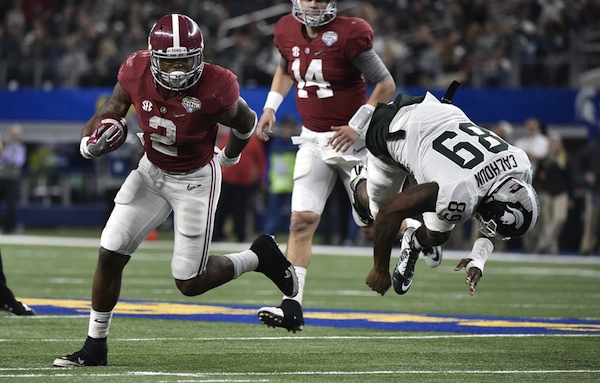
We love Christian McCaffrey, but Derrick Henry deserved the Heisman
A popular sentiment during the Rose Bowl, and in the hours following, was that Stanford RB Christian McCaffrey’s 368 all-purpose yards and two touchdowns showed that Heisman voters made a mistake choosing Alabama RB Derrick Henry.
It was the closest Heisman Trophy voting since Mark Ingram won by the slimmest margin ever in 2009. Still, Henry received 1,832 points, 293 more than McCaffrey, who finished with 1,539.
One theory was that Heisman voters and East Coast fans missed McCaffrey’s stellar performances because of late kickoffs. But what about a noon kickoff against Northwestern when he rushed for 66 yards on 12 carries, had four kick returns for 90 yards and one punt return for negative eight yards?
Sure, McCaffrey had a better Rose Bowl performance than Henry’s Cotton Bowl performance, but Henry doesn’t touch the ball on special teams. Yet in the regular season, which the Heisman is based on, Henry still had eight more total touchdowns, led the country in rushing yards (1,986) and rushing TDs (23).
Against the nation’s toughest schedule, Henry broke Herschel Walker’s single-season SEC rushing record, and tied Tim Tebow’s single-season rushing touchdown record. Because Kenyan Drake was injured for most of the season, Henry had to carry the load unlike previous Alabama rushing tandems Ingram-Trent Richardson and Eddie Lacy-T.J. Yeldon.
What’s more, Henry shined head-to-head against one-time Heisman frontrunner Leonard Fournette.
Both McCaffrey and Henry went over 100 yards and rushed for a touchdown in conference losses, so those cancel out.
While regional bias could be expected, and McCaffrey won the West while Henry won the South, Henry also won the Midwest, Southwest, Mid-Atlantic and Northeast. Those voters didn’t place much value in all-purpose yards, as McCaffrey had more than 1,000 more than the next closest player.
